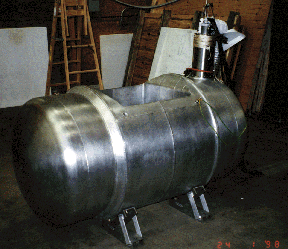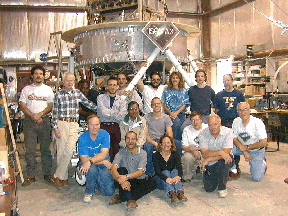Welcome
Press Release
Background
Detector
Data
Collaboration
Publications
Pictures
|

Ancient Cosmic Rays Captured by Powerful Magnet
On the Edge of Space
 A highly successful first flight of the Isotope Magnet Experiment (ISOMAX) took place this summer, launched from Lynn Lake, Manitoba, Canada. ISOMAX flew near the top of the Earth's atmosphere, at an altitude of 38 km (126,000 ft), carried by a huge 1.1 million m3 (39 million ft3) helium balloon. At full expansion, this balloon is about 64 m (210 ft) in diameter and at launch the balloon system is taller than an 80 story building. This experiment measures the only sample of material from outside our solar system we can obtain - the cosmic rays, atomic nuclei and electrons with speeds up to nearly the speed of light.
A highly successful first flight of the Isotope Magnet Experiment (ISOMAX) took place this summer, launched from Lynn Lake, Manitoba, Canada. ISOMAX flew near the top of the Earth's atmosphere, at an altitude of 38 km (126,000 ft), carried by a huge 1.1 million m3 (39 million ft3) helium balloon. At full expansion, this balloon is about 64 m (210 ft) in diameter and at launch the balloon system is taller than an 80 story building. This experiment measures the only sample of material from outside our solar system we can obtain - the cosmic rays, atomic nuclei and electrons with speeds up to nearly the speed of light.
ISOMAX uses a large superconducting magnet and a state-of-the-art suite of high-energy particle detectors to measure galactic cosmic ray nuclei, believed to originate in supernova explosions. Over millions of years in the Milky Way galaxy, these particles are accelerated to high speed and energy by encounters with rapidly moving magnetic fields, probably created by supernovae.
The ISOMAX instrument and balloon payload were developed by Goddard's Laboratory for High Energy Astrophysics, the University of Siegen (Germany), and the California Institute of Technology. The team spent seven weeks in Canada during the preparation, launch, recovery, and disassembly of the experiment.
The Instrument and the Launch
 The magnetic field in the center of the superconducting magnet can be more than 20,000 times the strength of Earth's magnetic field. Because of this strength, and the sensitivity of magnetic instruments on other experiments developed at GSFC, a special facility was built for the development of the ISOMAX instrument.
The magnetic field in the center of the superconducting magnet can be more than 20,000 times the strength of Earth's magnetic field. Because of this strength, and the sensitivity of magnetic instruments on other experiments developed at GSFC, a special facility was built for the development of the ISOMAX instrument.
 This instrument weighs approximately two tons and is about 4 m in height. The ISOMAX team, lead by Principal Investigator Dr. Robert Streitmatter and Experiment Manager Dr. John Mitchell, was able to overcome technical problems with the manufacture of the superconducting magnet that delayed the first launch by two years. The team built and tested the instrument at Goddard, then partially disassembled it and shipped it to Canada, where it was reassembled for flight. The instrument was up and running within a virtually unprecedented 3 days after arrival at Lynn Lake.
This instrument weighs approximately two tons and is about 4 m in height. The ISOMAX team, lead by Principal Investigator Dr. Robert Streitmatter and Experiment Manager Dr. John Mitchell, was able to overcome technical problems with the manufacture of the superconducting magnet that delayed the first launch by two years. The team built and tested the instrument at Goddard, then partially disassembled it and shipped it to Canada, where it was reassembled for flight. The instrument was up and running within a virtually unprecedented 3 days after arrival at Lynn Lake.
Scientific balloon flights starting from Lynn Lake must launch during a six-week time window in early summer when the high altitude winds over northern Canada have the right speed and direction. The ISOMAX launch turned out to be the very last launch opportunity for any project this past summer. The experiment flew over the Canadian countryside for 33 hours, landing near Peace River, Alberta, Canada. The ISOMAX team is now analyzing the data from this flight, which appear to be excellent.
Cosmic Ray Clocks
 The particles measured by ISOMAX give science information about conditions that they have encountered in their travels, both outside and inside of our solar system. Unlike visible light, however, the direction from which cosmic ray particles arrive at Earth does not indicate where they originated; magnetic fields and shocks constantly deflect them along the way. But the species and energy of the measured particle tells scientists a great deal.
The particles measured by ISOMAX give science information about conditions that they have encountered in their travels, both outside and inside of our solar system. Unlike visible light, however, the direction from which cosmic ray particles arrive at Earth does not indicate where they originated; magnetic fields and shocks constantly deflect them along the way. But the species and energy of the measured particle tells scientists a great deal.
The "life cycle" of a cosmic ray nucleus has several stages. Some are formed by nuclear reactions inside a star, then ejected into interstellar space, and accelerated to high energies. Others are formed directly in supernova shock explosions. The galactic magnetic field confines these particles, however they are produced, so that they travel through the interstellar medium (the gas and dust between the stars) for millions of years before arriving at Earth.
Collisions with the material in the interstellar medium cause some of the primary cosmic ray nuclei to break up into lighter secondary nuclei (see picture below). For example, an oxygen nucleus can lose a proton and become a nitrogen nucleus. Among the varieties of isotopes produced in this way are various long-lived radioactive nuclei, which can be used as "clocks" in much the same way that carbon-14 is used for archaeological dating. These include beryllium-10, aluminum-26, chlorine-36, and manganese-54. Beryllium-10 was the focus of this first ISOMAX flight, with a half-life 1.6 million years.
The half-life of a radioactive substance is the time taken for half the atoms in a radioactive substance to decay, and each substance has a unique half-life. By comparing the relative amounts of these radioactive isotopes with the stable ones in the cosmic rays, scientists can test different theories on the history of these particles in the galaxy.
The Future of ISOMAX
 Present ISOMAX measurements of cosmic ray nuclei extend from helium to oxygen and energies up to 1.5 billion electron volts (1.5 GeV). These data, and future measurements to about 4 GeV, will significantly improve the information that scientists use to study several important astrophysical questions:
Present ISOMAX measurements of cosmic ray nuclei extend from helium to oxygen and energies up to 1.5 billion electron volts (1.5 GeV). These data, and future measurements to about 4 GeV, will significantly improve the information that scientists use to study several important astrophysical questions:
- How long does it take for these cosmic rays to reach the Earth?
- How much matter do they travel through on their journey to Earth?
- What portions of their time are spent in the disk of our Milky Way galaxy and outside, in the galactic halo?
Two ISOMAX flights are planned for the next few years to gather more statistics on these rare isotopes and extend the data to even higher energies to help answer these questions more clearly.

Launch Movies from August 4, 1998:
QuickTime version
|


